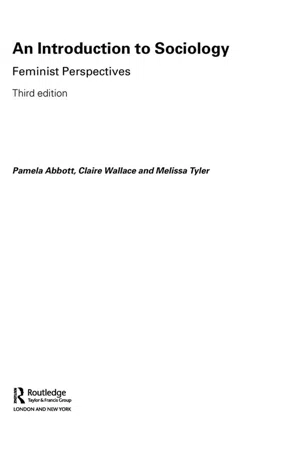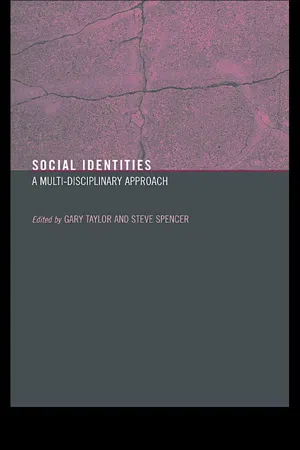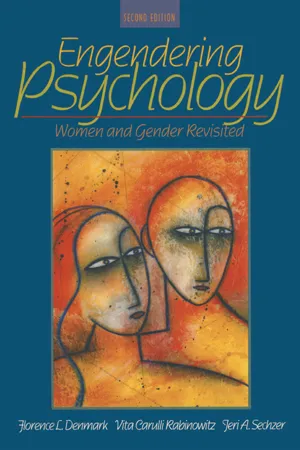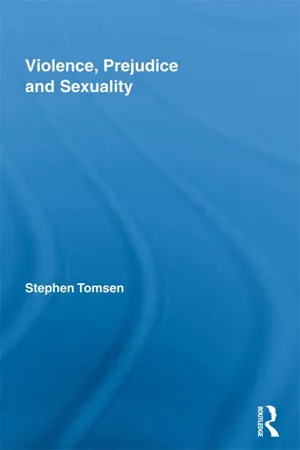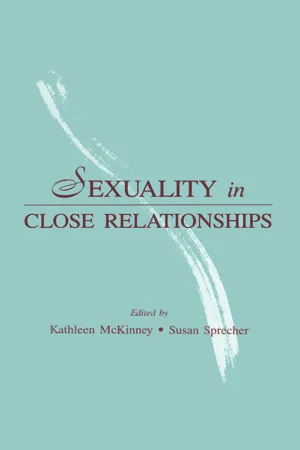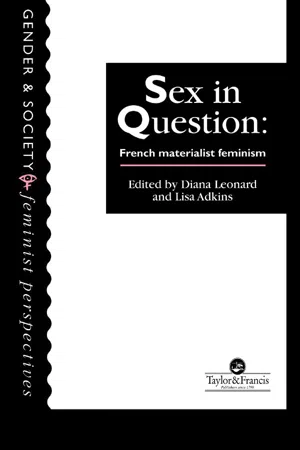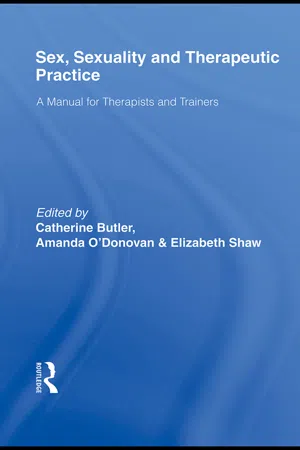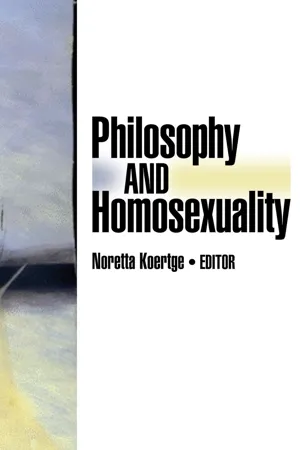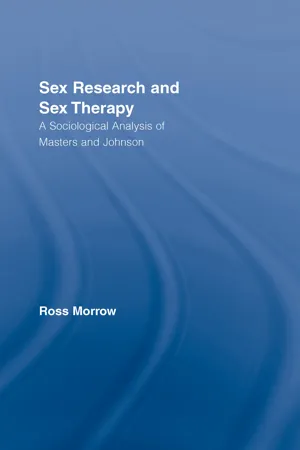Social Sciences
Sex and Sexuality
Sex refers to the biological characteristics that define male and female bodies, while sexuality encompasses a person's sexual orientation, desires, and behaviors. Both sex and sexuality are influenced by social, cultural, and individual factors, and are important aspects of human identity and experience. Understanding the complexities of sex and sexuality is crucial in addressing issues related to gender, relationships, and societal norms.
Written by Perlego with AI-assistance
Related key terms
10 Key excerpts on "Sex and Sexuality"
- eBook - ePub
- Julie Bywater, Rhiannon Jones(Authors)
- 2007(Publication Date)
- Learning Matters(Publisher)
Chapter 6 when we discuss ‘safer sex’. How then do the terms ‘sex’ and ‘gender’ differ? One view is that sex is about the biological and anatomical differences whereas gender refers to the psychological, social and cultural differences between male and female (Giddens, 2006). It is useful at this point to reflect back to the nature versus nurture debate concerning human growth and development (Crawford and Walker, 2003) and consider to what extent the differences between men and women are determined by their sex (i.e. biological) or by their gender (i.e. psychological, social and cultural). Are aspects of masculinity and femininity constructed and influenced by biology or society’s structures? Current feminist theorists would dispute this division by stating that society influences all the differences between women and men and using the terms ‘sex’ for biological differences and ‘gender’ for social and cultural differences is unhelpful. Scott and Jackson (2006) argue that the term ‘gender’ should be used to cover all aspects of what it means to be a woman or a man in terms of biological, psychological, social and cultural differences and that the term ‘sex’ should be used for sexual and erotic activity. These are debates that we will return to in later chapters.Sexuality
Sexuality is a difficult term to define as it depends on what theoretical perspective of sexuality you hold. An example is that if you believe that issues relating to sex, sexuality and sexual orientation are determined by biology and natural processes then your definition will be simple, concrete and immovable. Your definition will state that sexuality is that which is concerned with the reproduction of the species (Jackson, 1999, p.5). However, we would argue that sexuality is complex, fluid and involves many facets of human behaviour and being, which in turn is influenced by the historical, social, cultural and political context that we live in. Sexuality includes beliefs, acts, behaviours, desires, relationships and identities (Jackson, 1999; Weeks, 2003).Sexuality explained
Bremner and Hillin (1994) argue that sexuality is made up of sex and sexual practices, sexual orientation, sensuality, social relationships and political dimensions. These aspects all add up to how we define ourselves as sexual beings. Sexuality involves our relationships with ourselves, those around us and the society in which we live, whether we identify as gay, heterosexual, lesbian, bisexual or celibate. Below are the different aspects of sexuality and what each aspect may include. - eBook - ePub
An Introduction to Sociology
Feminist Perspectives
- Pamela Abbott, Melissa Tyler, Claire Wallace(Authors)
- 2006(Publication Date)
- Routledge(Publisher)
CHAPTER EIGHTSexuality
Sexuality is generally taken to refer to the social experience and expression of physical bodily desires, real or imagined, by or for others or for oneself. It encompasses erotic desires, identities and practices. Seemingly one of the most private, intimate aspects of our lives, sociologists have argued that sexuality is fundamentally social and political. This is because sexuality is experienced and expressed within relations of power and exchange and what we think of as sexual varies historically and culturally as well as in different social contexts. Sociologists have therefore argued that no human sexual behaviour or practice can be divorced from the social and political circumstances in which it takes place, and the social relations within which it is embedded. This means that even individual sex acts (such as masturbation or other forms of auto-eroticism) are social acts because the way in which we think about and make sense of them is shaped by a range of social values, attitudes, norms and sanctions. Yet sexuality remains something of a neglected topic in sociology when compared to say social class or the mass media, brought onto the sociological agenda only relatively recently. Largely as a result of the contribution of feminist sociologists and political activists sexuality has now begun to emerge as a legitimate focus of sociological concern. Indeed, that New Right movements in many Western societies have mobilised considerable political energies through their emphasis on the sanctity of the family, hostility to gay and lesbian sexuality and to ‘sexual deviance’ of various kinds is, as Jeff Weeks (1991, p. 12) has noted, something of a ‘back-handed compliment to the success of feminism’.Sexuality has been one of the main concerns of feminist theory and politics not least because feminists regard men’s control of women’s sexuality as one of the key mechanisms through which patriarchy is maintained. Feminists have drawn attention to the social control of women’s sexuality through religious, state and medical regulatory practices. In particular, feminists have emphasised the role of sexuality in reinforcing patriarchal power relations, highlighting issues such as pornography, sexual violence, clitoridectomy, prostitution and ‘compulsory heterosexuality’ (Rich, 1980) – the social compulsion to be heterosexual. Feminists have also made a significant contribution to theorising sexuality and the sexual body. They have also highlighted the relative neglect of issues of sexual identity in the social model of disability (Lloyd, 2001). Many have argued that the so-called ‘sexual revolution’ has merely been a means of increasing and legitimating a male right of sexual access to women. Others have highlighted, however, the ways in which sexuality can be a means of challenging and resisting women’s oppression. Feminist contributions have also drawn attention to the ways in which so-called scientific perspectives (including those developed by social scientists) have served to perpetuate women’s sexual oppression. - eBook - ePub
Social Identities
Multidisciplinary Approaches
- Steve Spencer, Gary Taylor(Authors)
- 2004(Publication Date)
- Routledge(Publisher)
4. SexualityJulia Hirst
Sexuality is one of the prime sites for the expression of identity. Yet, there is little consensus over what it is the term sexuality describes or its significance for the ways in which individuals experience and organise their lives. Nevertheless, there are defining features that unite particular perspectives. Commonplace usage in lay and popular discourse refers (simplistically) both to sexual practice (‘having sex’) and sexual identity (in making the distinction between hetero-, homo-, and bi-sexuality). Academic perspectives with origins in medicine, psychiatry, psychology, religion and sociobiology focus on the extent to which sexual identity and sexual behaviour are biologically and genetically determined as products of ‘normal’ and ‘natural’ instincts and drives. This emphasis on sexuality as a physically determined phenomenon is oft referred to as the essentialist view.The essentialist approach is problematised by social scientists (in sociology and critical social psychology) who argue that the biological basis of sexual expression is less important than the impact of society and processes of power in constructing particular identities and regulating sexual practices, choices and life chances. Debates in this arena are loosely labelled under the umbrella of social constructionist accounts of sexuality.By distinguishing the essentialist and social constructionist viewpoint I am not suggesting they occupy single theoretical or political positions. Broad assumptions certainly foreground how each sees the sexual as constituted and expressed but each span various perspectives, agendas and research approaches. Therefore, essentialist and constructionist accounts are best seen as occupying relative positions along a continuum if understanding of sexuality (and its implications for identity) is not to be constrained (Schwartz and Rutter, 1998). - eBook - ePub
Engendering Psychology
Women and Gender Revisited
- Florence Denmark, Vita Carulli Rabinowitz, Jeri A. Sechzer(Authors)
- 2016(Publication Date)
- Psychology Press(Publisher)
It is hard to imagine a topic in which gender matters more than sexuality. Gender surely influences people’s patterns of sexual desire and arousal, their responses to sexual imagery, and their sexual attitudes and practices. As we will see in this chapter, sexual behavior is a response to a complex mix of sociocultural, psychological, and biological forces and cannot be adequately understood in terms of any one force alone.In this chapter, we consider physical aspects of sexuality, research on the nature and extent of various sexual behaviors, sexual orientation, sexual fantasy, responses to sexual imagery, sexuality among those with disabilities, sexual dysfunction, and contraceptive use. But we begin with a discussion of how female sexuality has been socially constructed—how social realities affect how we identify, describe, classify, and ultimately experience sexuality.SEXUALITY IN A SOCIAL CONTEXTWe take a social constructionist perspective on sexuality that focuses on the historical and cultural contexts in which sexuality is learned and practiced. This view suggests that all societies organize sexual desires, behaviors, and identities into approved or encouraged, tolerated, and tabooed patterns (Lorber, 1994). These patterns are internalized by individual members of societies, who often come to view them as natural and inevitable, even biological, in origin.Both female and male sexuality are shaped by society and culture. To be sure, societal messages to males about sex are value laden and conflicting, and may pose many emotional and sexual difficulties for them (Kilmartin, 1994). But in most societies throughout history, sexuality is made problematic for females in ways that it is not for males (Gagnon, 1977; Gagnon & Simon, 1973). Some of these problems are due to the biological fact that sexual intercourse is far more consequential for females than males, because females alone bear children. But others result from the social reality that, throughout history, males have defined sexuality, including female sexuality, from their own perspective. Because of their historically greater physical, social, and economic power, men have been in positions to define when, how, with whom, and under what circumstances sex is appropriate, and they have often done so in ways that are disadvantageous to women. For example, the very definition of what constitutes “having sex” reveals a deeply androcentric (male-centered) and heterosexist bias (see Box 8.1 ). In Western societies, having sex usually refers exclusively to vaginal intercourse, involving male penetration and ejaculation. Hugging, touching, and kissing (which for some women are more stimulating than vaginal intercourse) do not count as having sex in this formulation. If they are considered at all, it is as foreplay - eBook - ePub
- Stephen Tomsen(Author)
- 2013(Publication Date)
- Routledge(Publisher)
Human sexuality has been understood as the sphere of life reflecting erotic desires and preferences. Many aspects of this are shaped by people's gender identities, such as the common gap that exists between the desire for casual sex by many men and the desire for romantic love among many women. The notion that males are masculine and active and females are feminine and passive appears as a natural complement to heterosexual relations. Yet gender is generally understood as the many social aspects of being masculine or feminine, and sexuality as the erotic realm of life. These are not identical to each other and sexuality should not just be discussed in the sole context of gender difference.The most significant commonsense view about human sexuality that pervades contemporary societies has often been referred to as essentialism. More broadly, this refers to an understanding of different social phenomena via an aspect of these that is assumed to be an innate, ongoing and core characteristic. In the sexual sphere, this constitutes the notion that sexual desire, acts and identities are the outcome of biological forces rather than historical and social factors.2 For example, much comment on sexuality refers to its innate and predetermined qualities based in bodily differences, hormones or unconscious instincts and drives that remain the same across different periods and cultures. The science that underpins this has an established tradition that is ongoing and well resourced. Various strands of research on this subject are founded on the idea that human sexual actions reflect biological drives which are ever present, though often constrained, in all societies (Weeks, 2003). These drives are understood to be of primary importance for the majority of men and women who are ‘naturally’ inclined towards exclusive opposite-sex relations in their adult sex lives.As homosexual behaviour subverts the straightforward link between gender and sexual desire and practice that essentialism assumes, it is a particularly problematic phenomenon. In fact, it is revealing that is has been regarded as more problematic than a range of other sexual aberrations that are quite antisocial in their consequences but still fit the heterosexual mould. Developing an explanation for same-sex desire and acts has been the central goal of many studies of sexuality in which homosexuality is conceived as a biological malfunction which repeatedly occurs in a minority of people. There has now been more than a century of ongoing scientific inquiry in the modern West that has been preoccupied with the body shapes, hormone levels, brain functions and inherited gene structures of homosexual men and women (Terry, 1999). - eBook - ePub
- Kathleen McKinney, Susan Sprecher(Authors)
- 2014(Publication Date)
- Psychology Press(Publisher)
And what is sexuality? As in the case of love, most researchers and writers on the topic have avoided definitions. Reiss (1986b) searched 20 human sexuality textbooks and found only 5 contained definitions of their topic, each quite different. Our own search through the literature yielded a similar paucity and a similar range. Some see human sexual behavior and motivation as "not biological but rather social and cultural phenomena" (Kon, 1987, p. 257). Or in Reiss' (1986b) words, sexuality "consists of those scripts shared by a group that are supposed to lead to erotic arousal and in turn to produce genital response" (p. 21). Others adhere to the biological understanding of sexuality as "first and foremost a mechanism by means of which species reproduce themselves" (Beach, 1977, p. 3). More typically, the definition falls somewhere in between, such as that of Strong and DeVault (1988), who described sexual behavior as "characterized by conscious physiological/erotic arousal (such as desire) and that may also be accompanied by physiological arousal ... or activity" (p. G-9).However, the core elements in most definitions seem to be physiological sexual arousal and sexual desire. Thus, we will use the following working definition: Sexuality is the constellation of sensations, emotions, and cognitions that an individual associates with physiological sexual arousal and that generally gives rise to sexual desire and/or behavior . Although this definition is structurally more complex than that of the definition of love, it also emphasizes a motivational element (sexual desire). This definition is also neutral with regard to how sexuality is constructed—biologically, developmentally, culturally, or whatever.A Dimension for Organizing Social Science Approaches to Sexuality and Love
One way to understand the variety of approaches to the relation between sexuality and love is to think of these approaches as lying along a dimension having two extremes—one arguing that love is a mere by-product of sexuality, of the physiological and behavioral reproductive systems dictated by human genes, and the other arguing that sexuality is a mere by-product of the cosmic yearning for love, for fusion, for union (see Fig. 2.1 - eBook - ePub
Sex In Question
French Feminism
- Lisa Adkins, Diana Leonard(Authors)
- 2004(Publication Date)
- Taylor & Francis(Publisher)
Chapter 4 Sexual, Sexed and Sex-Class Identities: Three Ways of Conceptualising the Relationship Between Sex and GenderNicole-Claude Mathieu1
This contribution began as a paper to the 10th World Congress of Sociology in 1982. The general theme was ‘Sociological Theory and Social Practice’. In reaction to what appeared an implicit presupposition of the title (that social actors do not have a theory of their own practice—but that happily sociology is there to provide one), my paper was entitled The conceptualisation of sex in social science practice and women’s movement theories’.2At the time, only the women’s movements and certain sections of the gay male movements had, in fact, furnished any sociological theorisation of the concept of sex—through their political questioning of relationships between the sexes, and hence of current notions of ‘man’ and ‘woman’. Such ideas certainly did not exist, or at least were not explicit, in 1970s social sciences (see, Mathieu, 1971, 1973 and 1977).The concept of sex involves the mental organisation of ideas (representations, myths, utopias, etc: ‘thought’ sex) and practices (social relations between the sexes: ‘acted’ sex), which are often contradictory. Whether the contradictions are emphasised or hidden, certain logics are set in place which this article will try to encompass.The ambiguity of the idea of sex, as manifest in commonsense, social science and women’s movements’ analyses, comes mainly from a required overlying of biological and social sex, at least in western societies. This is as central to the political polemics of feminist analyses and strategies as to the omissions and distortions of ‘scientific’ analysis.We therefore need to be aware of the type of problematic - eBook - ePub
Sex, Sexuality and Therapeutic Practice
A Manual for Therapists and Trainers
- Catherine Butler, Amanda O'Donovan, Elizabeth Shaw, Catherine Butler, Amanda O'Donovan, Elizabeth Shaw(Authors)
- 2009(Publication Date)
- Routledge(Publisher)
Across all stages of life, sexuality and sex shape our experiences of ourselves, our bodies, our relationships and our desire and need for intimacy and love. Establishing a sexual identity, finding meaningful and satisfying relationships and integrating sex and love are the tasks of a lifetime. Sexuality across the lifespan is defined by constantly evolving narratives around how we think about sex, sexual feelings, sensual touch, sexual risk-taking and well-being. A detailed understanding of Sex and Sexuality encompasses neurobiology, hormonal influences, developmental psychology, attachment, personality and rich social and cultural contexts. Current theories and knowledge are also powerfully shaped by limits and prohibitions on what areas of Sex and Sexuality it has been permissible to research. Remaining curious about our own, and our clients’, stories about Sex and Sexuality can help us to develop rich and compassionate understandings of these complex and changing narratives and facilitate ways to talk about sex.FURTHER RESOURCES
Development of sexuality
Hill, C. (2008). Human sexuality: Personality and social perspectives . Sage Publications. http://www.sagepub.com/hillhsstudy/ for online resources.Women’s Aid. National domestic violence charity has free resources for teaching children and young people about healthy relationships, respect and what to do if you are experiencing abuse. http://www.womensaid.org.ukPike, L.B. (2009). Sexuality and Your Child: For Children Ages 3 to 7 . Missouri, US: Department of Human Development & Family Studies, Uni Missouri. http://extension.missouri.edu/explorepdf/hesguide/humanrel/gh6002.pdfNo Outsiders Project—booklet and resources for use in primary schools and early years settings to support teachers and children to address lesbian, gay, bisexual and transgender equality. http://www.nooutsiders.sunderland.ac.ukChildren and young people
Brook. National voluntary sector provider of free and confidential sexual health advice and services specifically for young people under 25. Advice for professionals on sex and the law. http://www.brook.org.ukLondon Safeguarding Children Board. Service support for children professionals and local communities in safeguarding children. http://www.londonscb.gov.uk - eBook - ePub
- Noretta Koertge(Author)
- 2014(Publication Date)
- Routledge(Publisher)
In most instances the chromosomal sex and the morphological sex are congruent. When they are not, doctors have been known to be mistaken, as in the case of hermaphrodites. Gender identity refers to the individual's basic conviction of being female or male. This conviction is not necessarily contingent upon the individual's biological sex. In the case of post-operative transsexuals, gender identity is congruent with morphological but not with chromosomal sex. Gender identity is usually present by the time the child begins to talk. Social sex-role identifies the physical and psychological characteristics that are culturally associated with females or males. Social sex-role stereotypes are cultural expectations of appropriate physical and psychological characteristics of females and males. These characteristics are perceived as feminine or masculine. Six aspects of social sex-roles have been identified (Shively, Rudolph, & De Cecco, 1978): physical appearance, personality, mannerisms, speech, interests, and habits. Sexual orientation refers to the individual's physical sexual activity with, interpersonal affection for, and erotic fantasies about members of the same or opposite biological sex. Physical sexual activity designates the individual's erotic body contact with one or more persons; this may or may not include genital contact. Interpersonal affection refers to associations, involving varying degrees of love or trust, with coworkers, friends, lovers, and marital partners. These relationships do not necessarily include or exclude physical sexual activity. Erotic fantasies are the individual's mental images of one or more persons engaged in physical sexual activity or involved in idealized affectional (i.e., romantic) relationships. In the current research at C.H.E.E.R., social sex-role and sexual orientation are conceived along several independent continua - eBook - ePub
Sex Research and Sex Therapy
A Sociological Analysis of Masters and Johnson
- Ross Morrow(Author)
- 2013(Publication Date)
- Routledge(Publisher)
Secondly, if sexuality is purely a social construction and can have multiple meanings in multiple discourses then what, if anything, gives these discourses a common point of reference which would allow the term to be used comparatively in a meaningful way (Vance 1989, 21; Mohr 1992, 236)? As Vance (1989, 21) puts it, the object of study itself ‘becomes evanescent and threatens to disappear’. Some social constructionists, such as Michel Foucault have tried to totally deconstruct sexuality as a category and have run into this very problem (Morrow 1995). Others have sought to avoid it by assuming that certain types of behaviour and physical interactions can be reliably regarded as sexual even though they are found in different cultures and historical periods (Vance 1989, 21–3).The third problem concerns the role of the body in social construction theory. Social construction theory has been very useful in challenging the dominance of essentialist views that sexuality is simply a natural part of being human and is a product of biology. Yet as certain forms of social construction theory stress that sexual desire and impulse are culturally created there seems to be less and less room in such theory for bodily anatomy and physiology. What is the role of biology in people's sexual lives and how can the body be properly conceptualised within social construction theory without lapsing back into biological determinist forms of essentialism (Vance 1989, 23)?Those with essentialist views of sexuality tend to study the body because they believe it is the locus of truth about sexuality. Social constructionists, on the other hand, tend to regard the body as providing the physical basis of and potential for engaging in and experiencing various sexual acts. In their view, the body not only provides energy for sexual practices but is itself a site for the enactment and experience of various thoughts, feelings and behaviours which are regarded as sexual within a particular culture (Irvine 1995, 16). The body can also impose limits on a person's sexual expression. For example, if a male does not develop an erection, or if a female does not have a penetrable vagina, then there are limits as to what sexual activities they can engage in. At the same time, however, it is important not to over-estimate the biological dimension of sexuality (Mahoney 1983, 24). This is because it is people's culture which teaches them how to utilise the body's potential in order to ‘construct’ themselves as sexual beings (Irvine 1995, 16).
Index pages curate the most relevant extracts from our library of academic textbooks. They’ve been created using an in-house natural language model (NLM), each adding context and meaning to key research topics.

